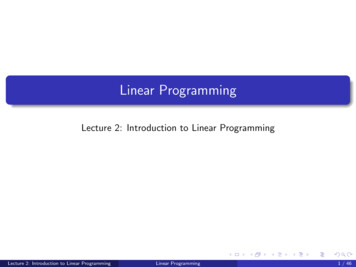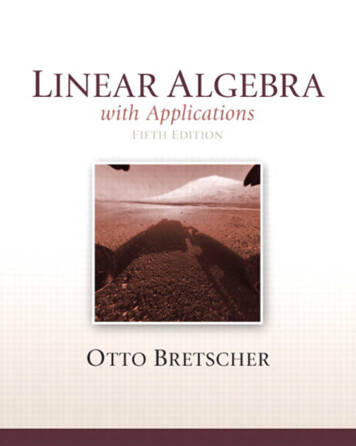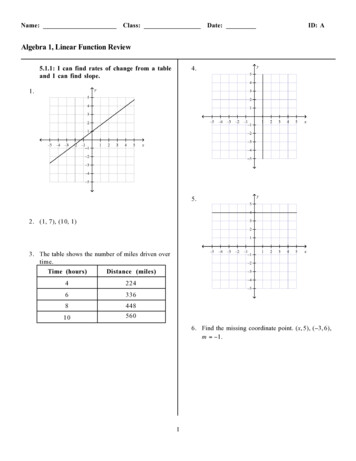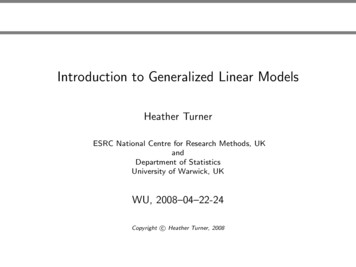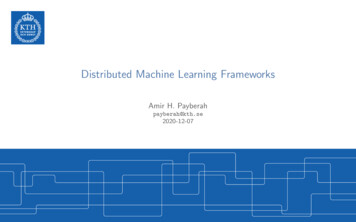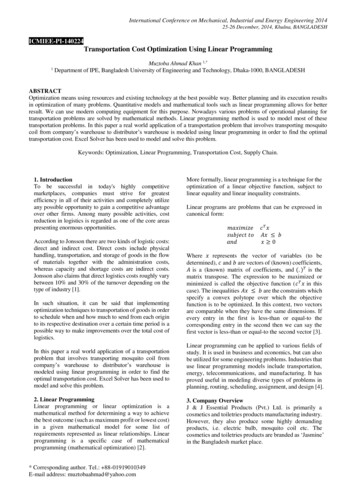
Transcription
Linear Learning with AllReduceJohn Langford (with help from many)NYU Large Scale Learning Class, February 19, 2013
Applying for a fellowship in 1997Interviewer: So, what do you want to do?John: I’d like to solve AI.I: How?J: I want to use parallel learning algorithms to create fantasticlearning machines!
Applying for a fellowship in 1997Interviewer: So, what do you want to do?John: I’d like to solve AI.I: How?J: I want to use parallel learning algorithms to create fantasticlearning machines!I: You fool! The only thing parallel machines are good for iscomputational windtunnels!
Applying for a fellowship in 1997Interviewer: So, what do you want to do?John: I’d like to solve AI.I: How?J: I want to use parallel learning algorithms to create fantasticlearning machines!I: You fool! The only thing parallel machines are good for iscomputational windtunnels!The worst part: he had a point.
Terascale Linear Learning ACDL11Given 2.1 TerafeaturesP of data, how can you learn a good linearpredictor fw (x) i wi xi ?
Terascale Linear Learning ACDL11Given 2.1 TerafeaturesP of data, how can you learn a good linearpredictor fw (x) i wi xi ?17B Examples16M parameters1K nodesHow long does it take?
Terascale Linear Learning ACDL11Given 2.1 TerafeaturesP of data, how can you learn a good linearpredictor fw (x) i wi xi ?17B Examples16M parameters1K nodesHow long does it take?70 minutes 500M features/second: faster than the IObandwidth of a single machine faster than all possible singlemachine linear learning algorithms.
MPI-style AllReduceAllreduce initial state5172634
MPI-style AllReduceAllreduce final state28282828282828
MPI-style AllReduceCreate Binary Tree7516234
MPI-style AllReduceReducing, step 178113234
MPI-style AllReduceReducing, step 2288113234
MPI-style AllReduceBroadcast, step 12828128234
MPI-style AllReduceAllreduce final state282828282828AllReduce Reduce Broadcast28
MPI-style AllReduceAllreduce final state28282828282828AllReduce Reduce BroadcastProperties:1Easily pipelined so no latency concerns.2Bandwidth 6n.3No need to rewrite code!
An Example Algorithm: Weight averagingn AllReduce(1)While (pass number max)1 While (examples left)1Do online update.2AllReduce(weights)3For each weight w w /n
An Example Algorithm: Weight averagingn AllReduce(1)While (pass number max)1 While (examples left)1Do online update.2AllReduce(weights)3For each weight w w /nOther algorithms implemented:1Nonuniform averaging for online learning2Conjugate Gradient3LBFGS
What is Hadoop AllReduce?Data1“Map” job moves program to data.Program
What is Hadoop AllReduce?DataProgram12“Map” job moves program to data.Delayed initialization: Most failures are disk failures. Firstread (and cache) all data, before initializing allreduce. Failuresautorestart on different node with identical data.
What is Hadoop AllReduce?DataProgram123“Map” job moves program to data.Delayed initialization: Most failures are disk failures. Firstread (and cache) all data, before initializing allreduce. Failuresautorestart on different node with identical data.Speculative execution: In a busy cluster, one node is oftenslow. Hadoop can speculatively start additional mappers. Weuse the first to finish reading all data once.
What is Hadoop AllReduce?DataProgram123“Map” job moves program to data.Delayed initialization: Most failures are disk failures. Firstread (and cache) all data, before initializing allreduce. Failuresautorestart on different node with identical data.Speculative execution: In a busy cluster, one node is oftenslow. Hadoop can speculatively start additional mappers. Weuse the first to finish reading all data once.The net effect: Reliable execution out to perhaps 10K node-hours.
Approach Used1Optimize hard so few data passes required.1Normalized, adaptive, safe, online gradient descent.
Approach Used1Optimize hard so few data passes required.123Normalized, adaptive, safe, online gradient descent.L-BFGS batch algorithm that approximates inverse hessian.Use (1) to warmstart (2).
Approach Used1Optimize hard so few data passes required.1232Normalized, adaptive, safe, online gradient descent.L-BFGS batch algorithm that approximates inverse hessian.Use (1) to warmstart (2).Use map-only Hadoop for process control and error recovery.
Approach Used1Optimize hard so few data passes required.123Normalized, adaptive, safe, online gradient descent.L-BFGS batch algorithm that approximates inverse hessian.Use (1) to warmstart (2).2Use map-only Hadoop for process control and error recovery.3Use AllReduce to sync state.
Approach Used1Optimize hard so few data passes required.123Normalized, adaptive, safe, online gradient descent.L-BFGS batch algorithm that approximates inverse hessian.Use (1) to warmstart (2).2Use map-only Hadoop for process control and error recovery.3Use AllReduce to sync state.4Always save input examples in a cachefile to speed laterpasses.
Approach Used1Optimize hard so few data passes required.123Normalized, adaptive, safe, online gradient descent.L-BFGS batch algorithm that approximates inverse hessian.Use (1) to warmstart (2).2Use map-only Hadoop for process control and error recovery.3Use AllReduce to sync state.4Always save input examples in a cachefile to speed laterpasses.5Use hashing trick to reduce input complexity.
Approach Used1Optimize hard so few data passes required.123Normalized, adaptive, safe, online gradient descent.L-BFGS batch algorithm that approximates inverse hessian.Use (1) to warmstart (2).2Use map-only Hadoop for process control and error recovery.3Use AllReduce to sync state.4Always save input examples in a cachefile to speed laterpasses.5Use hashing trick to reduce input complexity.In Vowpal Wabbit. Allreduce is a separate easily linked library.
Robustness & SpeedupSpeed per method10Average 10Min 10Max 0
Splice Site Recognition0.550.5auPRC0.450.40.350.3OnlineL BFGS w/ 5 online passesL BFGS w/ 1 online passL BFGS0.250.20102030Iteration4050
Splice Site Recognition0.60.5auPRC0.40.30.2L BFGS w/ one online passZinkevich et al.Dekel et al.0.10051015Effective number of passes over data20
Bibliography: VW & AlgsCaching L. Bottou. Stochastic Gradient Descent Examples on ToyProblems, http://leon.bottou.org/projects/sgd, 2007.Release Vowpal Wabbit open source project,http://github.com/JohnLangford/vowpal wabbit/wiki,2007.L-BFGS J. Nocedal, Updating Quasi-Newton Matrices with LimitedStorage, Mathematics of Computation 35:773–782, 1980.Adaptive H. B. McMahan and M. Streeter, Adaptive BoundOptimization for Online Convex Optimization, COLT 2010.Adaptive J. Duchi, E. Hazan, and Y. Singer, Adaptive SubgradientMethods for Online Learning and Stochastic Optimization,COLT 2010.Safe N. Karampatziakis, and J. Langford, Online ImportanceWeight Aware Updates, UAI 2011.
Bibliography: Parallelgrad sum C. Teo, Q. Le, A. Smola, V. Vishwanathan, A ScalableModular Convex Solver for Regularized Risk Minimization,KDD 2007.avg. G. Mann et al. Efficient large-scale distributed training ofconditional maximum entropy models, NIPS 2009.ov. avg M. Zinkevich, M. Weimar, A. Smola, and L. Li, ParallelizedStochastic Gradient Descent, NIPS 2010.P. online D. Hsu, N. Karampatziakis, J. Langford, and A. Smola,Parallel Online Learning, in SUML 2010.D. Mini O. Dekel, R. Gilad-Bachrach, O. Shamir, and L. Xiao,Optimal Distributed Online Predictions Using Minibatch,http://arxiv.org/abs/1012.1367Tera Alekh Agarwal, Olivier Chapelle, Miroslav Dudik, JohnLangford A Reliable Effective Terascale Linear LearningSystem, http://arxiv.org/abs/1110.4198
What is Hadoop AllReduce? 1 Data Program \Map" job moves program to data. 2 Delayed initialization: Most failures are disk failures. First read (and cache) all data, before initializing allreduce. Failures
